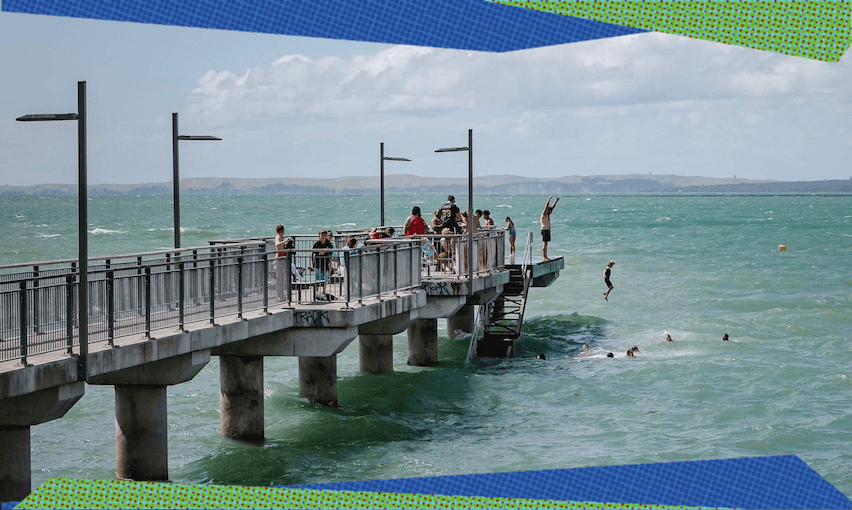Locals have been jumping off this North Shore wharf for generations. A 2016 rebuild made the whole experience even more fun.
Photos by Andrea James.
There’s probably a good reason for Murrays Bay wharf.
When it was first built in 1916, the wharf at Murrays Bay was one of only a handful on Auckland’s North Shore, making the East Coast Bays accessible to holiday makers and day trippers arriving by ferry. Takapuna and Browns Bay also had wharfs, but they’ve long since gone, replaced by the Auckland Harbour Bridge and its cars. Now Murrays Bay wharf is the only deep(ish) water wharf between Devonport and Whangaparaoa, a stretch of more than 20 kilometres.
I don’t know whether it’s because this wharf is the only place where you can load or unload a decent sized boat (therefore forming part of an emergency response plan) or whether Murrays Bay’s topography makes it the only sensible place for a wharf to be retained. Either way, whereas other local wharves have long since been removed, Murrays Bay wharf has been rebuilt, twice.
Anyone who’s been to Murrays Bay in the summer knows that the wharf is no longer used by boats. Even the Murrays Bay Sailing Club doesn’t use it. It was the last rebuild, coinciding with the centenary of its construction in 2016, that provides a clue as to the wharf’s true value, and why it’s still there.
The wharf is 60 metres long, and at high tide it sits about three metres above approximately three metres of water. An ideal spot, in other words, for executing the perfect manu.
On a busy summer’s day, when high tide’s somewhere in the middle of the day, hundreds of people make their way to Murrays Bay wharf, squeeze past the fishermen, and jump off. Those who jump are an amazing cross section of society – all shapes, sizes, ages and colours. The wharf’s wooden steps, ostensibly for boat access, mainly operate one way, enabling jumpers to make their way back up for another manu. And another.
Murrays Bay wharf is a piece of social infrastructure. High enough to be scary, safe enough to be encouraging. Leaping from the wharf is challenging, but also potentially hours of fun. Climbing onto the timber handrail, adding another metre of height to your jump, adds another level of challenge. Climbing the lampposts for an extra three metres is possible, but not exactly recommended. The brief installation of a trampoline last year was a step too far, at least according to the concerned members of the local Facebook group who swiftly got it removed.
When the wharf was rebuilt, at a cost of $16m, it was an acknowledgement not just of its historic value, but also its contemporary importance to the entire Murrays Bay community. It was made wider, creating more space for more people. Filleting boards were added to keep the walkway clean of fish. Seats were provided, as was a ladder.
Most importantly, in a flagrant rebuke to health and safety over-anxiety, the final few metres were kept clear of handrails, creating a broad platform designed for jumping. The deck of this platform is timber, easier on bare feet. It’s wide enough that you and your friends can stand at the edge, but there’s also enough room to stand safely away from it. While it must have been tempting to load this end of the wharf with safety features and restraints, instead they were removed, ultimately making it a safer place for people to do what they were going to do anyway.
Murrays Bay wharf isn’t an essential piece of Auckland infrastructure. It embodies a generosity of spirit that all public buildings should have. It’s a structure that goes beyond its pragmatic purpose to bring joy to our lives.
For Year 6 graduates of the local primary school, “wharf jump” is a rite of passage. The wharf at Murrays Bay is a place where boundaries are pushed, kids grow up, and memories are made. It’s a place that brings the community together, and that’s reason enough for it to exist.
Mat Brown is an architect, design manager and co-host of 76 Small Rooms, a podcast about Architecture in New Zealand.

